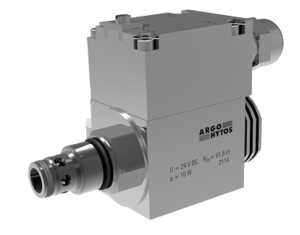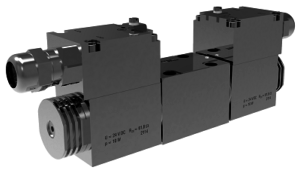Potentially explosive mixtures of gas, vapor, mist or dust aren’t unusual in many chemical and petrochemical plants or, for example, in mines. Thus, it is necessary to ensure a high level of protection against explosion for every component on equipment used in these industries, according to officials at ARGO-HYTOS, Zug, Switzerland.

New One4All solenoids are designed for all explosion-risk areas and temperature classes and offer excellent hydraulic power performance for explosion-proof valves.
When using hydraulic components, a common protection method is to prevent the accumulation of energy which would be sufficient to ignite an explosive mixture. Specifically, that means the design of these units must focus on preventing explosive mixtures from entering a space where they can cause sparks.
ARGO-HYTOS offers two types of protection on the electrical parts of its valves: Type “Ex e” for increased safety for the connection terminal on dc coils; and type “Ex mb” which entails encapsulation on the ac coils with a rectifier bridge.
It is also important to limit the maximum surface temperature of individual parts of the valve. Hydraulic fluids in these types of applications usually reach operating temperatures of about 55°C. This temperature is much lower than the maximum allowable temperature for the individual parts. Therefore the hydraulic part of the valve cools the entire assembly. The only part on which the surface temperature has to be reduced is the solenoid.
A solenoid design that allows better heat radiation to the surroundings—and also lowers power consumption—significantly reduces the surface temperature. Unfortunately, reducing power consumption normally results in lower hydraulic performance from the valve. Therefore, valves designed for explosive environments typically transmit lower hydraulic power than conventional valves.
ARGO-HYTOS has launched a new range of directional-modular and screw-in valves for the explosion-proof market to overcome this typically low hydraulic power phenomenon.
New One4All explosion solenoids are designed for all explosion-risk areas and temperature classes, in part thanks to the latest CFD modeling techniques, resulting in an excellent hydraulic power performance for explosion-proof valves, according to ARGO-HYTOS officials.

Explosion-proof RPEX3 size 6 (D03) solenoid-operated directional control valve is rated for flow of 16 gpm at pressures to 5,100 psi.
The company offers two basic ranges of modular valve and screw-in cartridge versions. The One4All 10-W solenoids, intended for use with valves in potentially explosive atmospheres, perform similar to conventional 30-W solenoids. The design also lets technicians open the electrical terminal box cable installation without losing its ATEX/IECEx certificate’s validity.
In addition, the explosion-proof valves bear all the unique features that apply to the standard ARGO-HYTOS valve range, said the company. These include:
• Robust design rated for 10 million life cycles, which includes the seals.
• Screw-in cartridge poppet valves with zero leaks and a pressure rating of 420 bar.
• Screw-in spool valves with a “tumbling nose“ to compensate for valve cavity misalignments, so the spool never blocks.
• High oil and ambient temperature capabilities.
• Surface protection of 500 hr per ISO 9224 as standard.
• Special spool versions, such as detents, available on request.
• GOST TR (Russia Federation) Certification for all explosion-proof ranges.
• Bayonet manual override approved for all CETOP and SIC versions.
• Solenoid interchangeability between CETOP and SIC explosion-proof ranges.
ARGO-HYTOS
www.argo-hytos.com
Filed Under: Mobile Hydraulic Tips